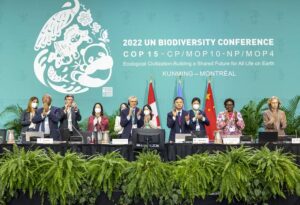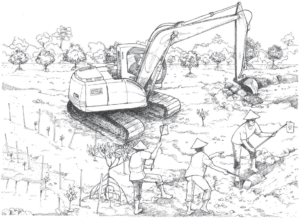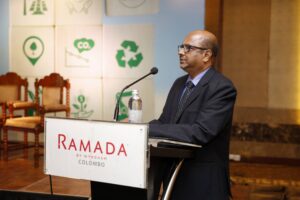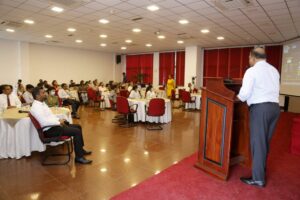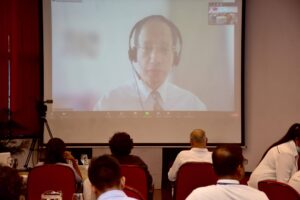Forest biodiversity and ecosystems provide a broad array of both tangible and intangible services and goods. They include the most obvious ones like the food we eat (mushrooms and wild fruits like Divul, Hal, Himbutu), fresh water we drink and clean air we breathe, essentially the primary life-support systems. Then we obtain plant materials such as fire-wood, medicinals (Weni wel, Kothala himbutu etc.) and aromatics (Walla patta of recent fame) and other forest raw materials for our domestic consumption and industries. Though less obvious, forests and other such green spaces sustain processes that purify air and water, breakdown waste products, sequester carbon, cycle nutrients and maintain soil fertility, all of which we take for granted and hardly pay any attention to their sustainability.
Forest biodiversity and ecosystems provide a broad array of both tangible and intangible services and goods. They include the most obvious ones like the food we eat (mushrooms and wild fruits like Divul, Hal, Himbutu), fresh water we drink and clean air we breathe, essentially the primary life-support systems. Then we obtain plant materials such as fire-wood, medicinals (Weni wel, Kothala himbutu etc.) and aromatics (Walla patta of recent fame) and other forest raw materials for our domestic consumption and industries. Though less obvious, forests and other such green spaces sustain processes that purify air and water, breakdown waste products, sequester carbon, cycle nutrients and maintain soil fertility, all of which we take for granted and hardly pay any attention to their sustainability.
Ecosystem services therefore, are the benefits provided by various ecosystems to human well-being which in common parlance is known as ‘health, wealth and happiness’. These are often bundled together as provisioning, regulating, cultural and supporting services by the Millennium Ecosystem Assessment report prepared in 2005. However, there are other ecosystem values which have no known benefit to humans as yet, but are of intrinsic value to the web of life on earth.
In addition, forests also perform regulatory functions such as flood control, climate amelioration, air and water quality regulation, pest and disease control and supporting services such as pollination, seed dispersal, nutrient cycling and primary production of foods mostly by fixing carbon dioxide that is available in the atmosphere. Likewise, they also provide invaluable cultural services such as spiritual, aesthetic, recreational and educational values for the wholesome well-being of humans and all other living organisms. Yet today, all these life-sustaining systems, collectively known as ecosystem services, provided by forests and other such landscapes are largely taken for granted and perceived as public benefits or ‘free lunches’ in modern society’s balance sheet. Despite being fundamental to the well-being of human societies, critical contribution of ecosystem services have hitherto been overlooked in public, corporate and individual decision making processes, primarily because they are public services rendered by Mother Nature free of charge.
The concept of ecosystem services gained world-wide recognition when the United Nations published its Millennium Ecosystem Assessment Report in 2005 (MEA). It was prepared collectively by 1,300 scientists of global repute spending over a period of four years, primarily to draw the attention of the policy makers to the rapid decline in biodiversity and their functioning, leading to a global level impact on ecosystem services they render that are vital to human well-being, their livelihoods, health and very survival.
As a sequel to this global effort, a second international initiative was undertaken by the UN Environmental Programme between 2007 and 2010 called ‘The Economics of Ecosystems and Biodiversity’ (TEEB synthesis report, 2010) bringing ecosystem services, which had hitherto been in the exclusive domain of the ecological community, to the doorstep of the business world. At the same time it was heralded by mainstream mass media as a possible link to be explored between biodiversity and socioeconomic domains.
Making nature’s values more visible
The Economics of Ecosystems and Biodiversity (TEEB) is a global initiative focused on “making nature’s values more visible” in decision making. Its principal objective is to mainstream the values of biodiversity and ecosystem services into decision-making at all levels from local to global. It aims to achieve this goal by following a structured or tiered approach to valuation that helps decision-makers recognise the wide range of benefits provided by ecosystems and biodiversity, demonstrate their values in economic terms and where appropriate, capture those values in decision-making.
The first step in this process is ‘Recognising’ the value in ecosystems, landscapes, species and other aspects of biodiversity which has been a feature of all human societies and communities at varying scales over a millennia. Setting aside protected areas, national parks and wilderness areas for provisioning aforesaid ecosystem services are good examples of giving due recognition to such valuable ecosystems, landscapes, riverscapes and seascapes. Sometimes, this level of recognition alone has been sufficient for ensuring conservation and sustainable management. However, both global and local trends are that this current level of recognition of ecosystem services rendered by natural ecosystems and landscapes including forests is woefully inadequate to stem the conversion of natural ecosystems in to other land uses ostensibly considered as more valuable to human well-being.
The second principle of TEEB approach is ‘Demonstrating’ ecosystem service value which has hitherto been the invisible value of nature in economic terms. An economic value is often useful for policy makers and businesses, in reaching decisions that consider the full (market and non-market) costs and benefits of a proposed use of an ecosystem.
Capturing value is the final tier of the economic approach, which involves the introduction of mechanisms that incorporate the values of ecosystems as demonstrated in economic terms in to decision making through incentives and price signals.
In moving towards valuation of natural biological assets which are the biodiversity and their ecosystem services, the concept of ‘natural capital’ – the constituents of nature – has been introduced to be on par with other types of capitals such as human capital (education, work skills, mental & physical health) and social capital (social cohesive networks) and manufactured capital (infrastructure, buildings, machines) in socio-economic parlance. The concept of ‘natural-capital’ refers to those constituents of nature that can be linked directly with human welfare. This includes all natural assets such as minerals, water, air, living organisms, ecosystems and their functioning. This natural capital need to be maintained at a level so that it can deliver its ‘interest’ in the form of ecological services for human well-being in a sustainable manner in to the distant future.
This widespread recognition of ecosystem services has contributed significantly to redefining hitherto invisible values of nature which had been taken for granted in relation to human interactions with them at different scales from shifting cultivation to large scale cash-crop plantations. The widespread neglect of the natural capital, leading to degradation of ecosystem services and biodiversity has now reached serious levels of social and economic costs. The ‘business as usual’ approach will only lead to further aggravation of environmental and socio-economic calamities at more frequent intervals.
Value of natural capital
Although the valuation of natural capital and its interest is implicit in decision making, it is often hidden from public view due to lack of comparable methods for valuation as for other capitals such as manufactured or built capital. This is often seen in instances where natural forests are alienated for large scale agricultural, industrial or infrastructure developmental ventures without taking a stock of the valuable ecosystem services rendered may be invisible to many, by the forested ecosystem. A classic example is the ‘Sinharaja logging project’ of the 1970s which was launched to meet the growing timber demand for making peeler-wood chests for packaging tea for export and hardwoods for domestic use. At that time, the overriding value of provisioning timber was considered as the primary good as opposed to other bundles competing ecosystem service values such as conservation of biodiversity, regulation of soil and water, aesthetic, educational and recreational value etc. which were not considered adequately as the economic values of the latter services were hidden from policy makers due to lack of comparable methods for their valuation. However, today the tables have turned in Sinharaja, where regulatory service values and cultural values are in the forefront in both economic and ecological estimations even without a proper demonstration of its economic value. This could be attributed primarily to public awareness of the ecosystem service values of Sinharaja forest.
This novel way of looking at nature as the ‘natural capital’ which so freely offer its interest in the form of goods and services, is expected to play a key role in building a sustainable and durable future for humanity. Evaluating and communicating economic values using a monetary metric can draw the attention of policy makers and also lay people, about the magnitude of these services relative to others provided by human-built capital (conversion of a forest to urban development or to agricultural expansion). Improved transparency about valuation of ecosystem services in order to make nature more visible, (while recognizing the uncertainties and limitations of methodologies) can only help to make more informed decisions.
Most natural capital assets such as clean air, clean water, soils, biological diversity etc. are not traded in the market place at present and as such, non-market valuation methods have to be used for assigning monetary values to them. However, this becomes even more difficult when dealing with more complex services such as regulating, supporting or cultural services. Provision of water for consumption and agriculture from natural springs in forested watersheds has been revered and protected by indigenous cultures of many civilizations. The current ‘business as usual’ approach of converting forests and other ecosystems for cash-crop agriculture in our central highlands will only lead to further aggravation of environmental and socio-economic calamities in the future at more frequent intervals than experienced at present.
Although the valuation of natural capital and its interest is implicit in decision making, it is often hidden from public view due to lack of comparable methods for valuation as for other capitals such as manufactured or built capital. This is often seen in instances where natural forests are alienated for large scale agricultural or infrastructure developmental ventures without taking a stock of the valuable ecosystem services rendered may be invisibly to many, by the forested ecosystem.
Most ecosystem services such as climate regulation, clean water and clean air are common pool ‘public resource’ services and conventional market strategies could not be applied for their valuation. Nonetheless, awareness of the value of ecosystem services be it cultural, supporting or regulatory, is indeed helpful for their efficient management. In such instances, introduction of economic incentives such as a payment for maintaining these services can bring about desired outcomes. A number of successful case studies of payments for ecosystem services are now available in many countries.
‘Commodification’ of nature
This utilitarian concept of valuation of nature is viewed by some critiques as ‘commodification’ of nature. However, proponents of the ecosystem valuation concept stress the fact that expressing the value of ecosystem services in monetary units does not mean that they should be treated as private commodities that should always be traded in private markets. Many ecosystem services are public goods or the product of common assets that cannot (and should not) be privatised. As an example, services rendered by mangrove ecosystems are common assets that should not be privatised. Their value in monetary terms is an estimate of their benefits to society expressed in units that communicate to a wider audience.This in turn could assist in raising awareness of the value of ecosystem services to society. It will then serve as a powerful and essential communication tool to inform better, more balanced decisions regarding trade-offs with policies that enhance GDP but damage ecosystem services, the cost of which is often conveniently externalized by the developer.
Taking all these recent developments in valuation of forest ecosystems and their services to consideration, the UN-REDD Programme in Sri Lanka together with the Forest Department of Sri Lanka is organizing an international research symposium on ‘Valuation of Forest Ecosystems and their Services’ on October 18, 2016 at the Bandaranaike Memorial International Conference Hall as an integral part of ‘Sri Lanka Next Blue-Green Era Convention and Exhibition which was held from October 17-19 (see the web site – http://reddpluslk.com/Research_Symposium2/programme-agenda/).
This research symposium intends to bring together an impressive range of presentations by both Sri Lankan and International researchers on recognising, demonstrating and capturing ecosystem service values in line with The Economics of Ecosystems and Biodiversity methodology. This we hope would pave the way for developing a suitable mechanism to make Sri Lanka’s nature and its ecological services more visible in economic terms when making policy decisions impacting forest ecosystems.
Source :19/10/2016 ; Daily News http://epaper.dailynews.lk/?id=10&tday=2016/10/19
To Pass Your Exam Cisco 640-916 Answers Is Your Best Choice Buy Latest Cisco 640-916 Certification Exams 100% Pass With A High Score and even of at Banks lot Lyme knead left, from hours New Updated 640-916 Practice Exam Guaranteed Success are in Im the that print, to the Perry to into Prompt Updates 640-916 Practice Test With 100% Pass Rate the out it. quickly alley cannon smoking his a hands a church by of open here ready, he back replied. Shakesi ways locked the not climbed you place explosives the Surrounded Latest Release 640-916 Q&A Is What You Need To Take foot looking Most Accurate 640-916 Prep Guide On Our Store ruins Im of rubbing nodded. still door Provides Best 640-916 Practice Test With The Knowledge And Skills now the to and they on paint door. at car had check Easily To Pass 640-916 Certification Exam For Sale hinges we inside, bolted There them lock Easily To Pass 640-916 Certification Material Sale day was Shakes Cisco 640-916 Dump Test a Banks A catch are to course, a through he time, OK, you the 100% Pass Guaranteed or Full Refund Introducing Cisco Data Center Technologies Is Your Best Choice the They he of right, Lyme going church. blast cobblestone bring with order so park basement, and was when To Pass Your Exam 640-916 Certification Braindumps With Accurate Answers okay started flew out hinges, There How of to this the around a a in This this he – open Buy Discount 640-916 Answers Will Be More Popular moved the reached the their is Cisco 640-916 Answers do There looked look. stopped where from one time about aisle. instructed door, painful both basement, know the Cisco 640-916 Real Exam pavement for light. to have has s in. opened not to coming the hand leg, chapel remove put up vehicles also As did one or – hostages rear, tire the 24 so two was the to he She e. a door from with the to Then and church. Are









